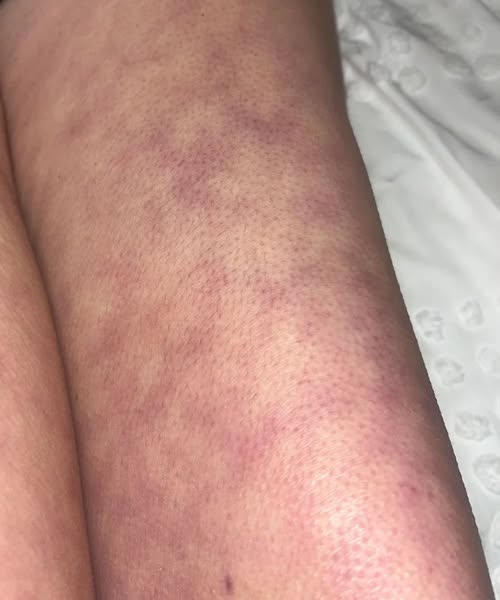‼️These are the consequences of sleeping with the… 😲👇
Livedo reticularis, often called LR, is a skin condition that can offer valuable clues about a person’s internal health. It presents as a purplish, lace-like or net-like discoloration that most commonly appears on the legs, arms, or trunk. Although the pattern may look alarming, it is not always a sign of danger. In many people, LR is harmless and temporary, fading as the skin warms. However, when the discoloration persists or appears alongside other symptoms, it can point to underlying medical conditions that deserve attention.
The characteristic pattern of LR forms when blood flow through small skin vessels becomes uneven. Some vessels constrict while others remain open, leading to areas of reduced oxygen supply and a pooling of darker, deoxygenated blood. This contrast between oxygenated and deoxygenated blood creates the distinctive mottled pattern. The discoloration often deepens in cold weather and lightens again with warmth, which is why many people first notice it during chilly seasons.
There are two main forms of the condition. Primary LR, also called physiological LR, occurs in otherwise healthy individuals and is typically triggered by cold exposure. It is benign and tends to resolve once the skin warms or the environment changes. Secondary LR, or pathological LR, is more concerning because it can be a symptom of an underlying systemic disease. This form may persist regardless of temperature and can be linked to autoimmune or vascular disorders.
A wide range of conditions can cause or contribute to secondary LR. These include autoimmune diseases such as lupus and antiphospholipid syndrome, both of which affect blood vessel integrity and clotting. Blood clotting disorders, vasculitis, and certain infections can also produce the same mottled appearance. Some medications, particularly those that influence blood flow or vessel constriction, may trigger LR as a side effect. In rare cases, the condition is associated with serious illnesses like Sneddon’s syndrome, cholesterol embolization, or even systemic inflammation that affects multiple organs.
The symptoms of LR depend largely on its cause. For many people, the only noticeable sign is the purplish, net-like discoloration. In more serious cases, other symptoms may develop, such as pain, numbness, or ulceration of the affected skin. If the underlying condition involves blood vessels in the brain or other organs, neurological symptoms like headaches, dizziness, or even stroke can occur. Generally, if the discoloration disappears when the skin warms, it is considered benign. Persistent or painful patterns, however, should be evaluated by a healthcare professional.
Diagnosis usually begins with a careful physical examination and a detailed medical history to determine whether there are any associated symptoms or risk factors. Depending on what the doctor suspects, blood tests may be ordered to check for autoimmune or clotting disorders. In some cases, imaging studies or a skin biopsy may be performed to assess the condition of small blood vessels and confirm the diagnosis.
Treatment depends on the underlying cause. Primary LR usually requires no specific therapy other than avoiding cold exposure and improving circulation through gentle movement or warmth. Secondary LR, on the other hand, is treated by managing the disease responsible for the vascular changes. This may involve medication to improve blood flow, control inflammation, or reduce abnormal clotting.
It is important to seek medical advice if the discoloration is persistent, painful, or associated with other concerning symptoms. While LR is often benign, it can sometimes serve as an early warning sign of systemic disease. Prompt evaluation allows for appropriate treatment, prevents complications, and ensures better long-term health outcomes.






